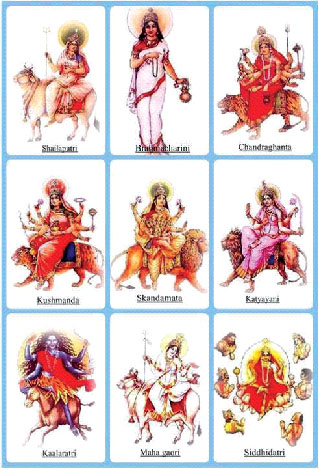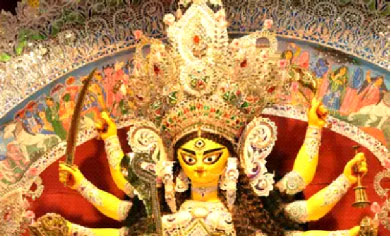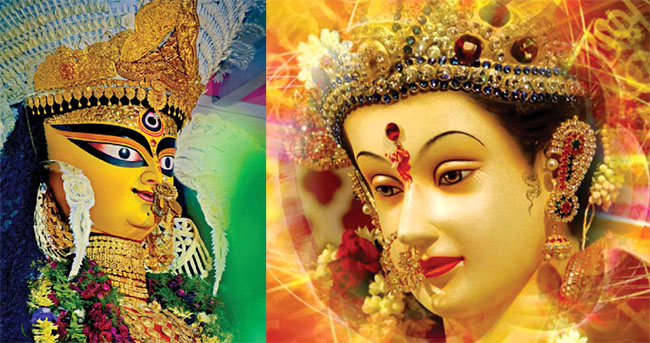Navratri (or the nine nights) come twice a year, marking a change in season –giving us a time to detox our body and mind and an opportunity to reset and rejuvenate. It’s also the time for spiritual and physical cleansing, seeking guidance from and celebrating the Divine Feminine/Maa Shakti, and reaching out to her dual nature of love, ferocity, compassion and power. In Sanatan Dharma, when we talk of Shakti, we refer to the raw, elemental energy of nature, mother earth, and also our own — lying dormant sometimes — the true life force that is inside us—nourishing us constantly through an invisible umbilical cord.
But most Hindu festivals are often marred by accusations from Left liberals. If Diwali ‘increases the AQI’, then around Holi they talk of hooliganism and water conservation. The same way, during Durga Puja, one has often seen pictures of a beaten and bruised Durga –trying to imply how the current state of our society and country does not worship women, in fact they have very little rights. This narrative needs to be questioned by not only looking at the past –where woman power was seen as naturally existing –but also present-day Bharat to see if our policies are in sync with the Sanatan view on Nari Shakti.
This Navratri let’s examine if the Bharat of today is celebrating that womanhood, which we have always known to be true. Sanatan Dharma does not need to follow the Western concept of feminism or “Women’s Empowerment”. Our women were always empowered. They were always recognised for the role they played not only at home but also in society. Modi’s Bharat today is borrowing from the same past by acknowledging Nari Tu Narayani. We have always believed in the ideas of Griha Lakshmi, where policies like “PM Ujjwala Yojana” ensure financial inclusion. The Government has also launched Mahila Shakti Kendras to empower rural women with opportunities for skill development, employment, digital literacy, health, and nutrition. emphasising on women-led development rather than the West’s idea of women development. According to statistics, under the Pradhan Mantri Mudra Yojana (PMMY) over 70 per cent of the beneficiaries are women, especially those belonging to the marginalised sections of the society.

Prime Minister Narendra Modi acknowledged from the ramparts of the Red Fort, of how 6,000 Jan Aushadhi Kendras had provided around five crore sanitary pads at Rs one, to poor women in rural India. Menstruation as a taboo topic is a very Victorian way of thinking. In Sanatan Dharma, we even have a form of Adi-Shakti, Maa Kamakhya who’s worshipped, when she’s believed to be menstruating, and the four days also witness celebration with a mela. From defining the nation’s first menstrual hygiene protocol, the Government has also amended the Medical Termination Pregnancy Act of 1971, giving women reproductive rights over their bodies and increasing the fetal gestation period from 20 to 24 weeks. All across our epics and texts we have stories of various women who have chosen to lead their pregnancies with complete autonomy and responsibility –so again pregnancy and motherhood have always been acknowledged in our society as primarily a woman’s prerogative. Having said that the Government has banned commercial surrogacy which had led to mushrooming of illegal IVF and surrogacy clinics. We have always placed a lot of significance to Garbh Sanskaar, believing the nurturing of a womb should not be cheapened as its’s an honour where one passes on their energy and thoughts on to the baby. The story of Abhimanyu learning war skills merely by listening to a conversation between his parents is not only a folk tale –but something which is now medically proven as more and more doctors advise meditation and listening to good happy news when one’s pregnant.
Celebration of Feminism

The first set of nights is traditionally spent meditating upon the Divine Feminine in her powerful and reconstructive, often mistaken as destructive aspect known as Durga or Kali. We go inwards and reach out to Durga or Kali to eliminate those aspects of ours that are causing self-harm. The second set of nights is spent meditating upon the Divine Mother in her spiritual and material wealth-giving aspect known as Lakshmi. The third set of nights is spent meditating upon the Divine Feminine in her spiritual wisdom-bestowing aspect known as Sarasvati. We ask the goddess to help us to achieve self-realisation and understand universal truths such as our divine nature and the interconnectedness of living beings.
Hindus also accept all forms of femininity as equally relevant and strong, no matter what their form of expression is. For example, ShailPutri or Daughter Of Mountains is worshipped for her unwavering devotion and commitment to those around her. Brahmacharini is a form of the goddess who performs Tapa or her own spiritual journey, choosing not to get married or attached. As Kalaratri-one who does good, she is in her most fierce form of goddess Durga, invoking fear. This form of Goddess is believed to be the destroyer of all negative energies. The avatar of Siddhidatri– Giver of Supernatural Power or Sidhis is the mistress of all achievement and perfections. Before the manifestation of the universe, when nothing else existed, there was the omnipresent formless divine consciousness. This is also called as static consciousness or Shiva in Hindu scriptures. When the time ripened for the manifestation of the universe, the first to manifest was the dynamic consciousness (shakti) from the static consciousness. Shakti is the feminine power of Shiva and is the creative force behind the universe. Shiva alone, as masculine power, is not capable of creating anything without its feminine power, hence the first to manifest in his own creative feminine power as shakti who was then allowed to create the universe. The Divine Mother which has given birth to the universe also nurtures and sustains it, and has the power to destroy (dissolve back) the same.
No discussion on Prime Minister Narendra Modi’s initiatives for women can be complete without elaborating upon the landmark Beti Bachao Beti Padhao (BBBP) initiative, launched at Panipat in Haryana, in 2015. It is more than just an energizing slogan; it is being considered as the government’s policy cornerstone. The objectives of the scheme are to prevent gender-biased sex selective elimination, and to ensure the survival of the girl child.
Cabinet approval for an ordinance to bring in amendments to the Protection of Children from Sexual Offences (POCSO) Act to ensure death penalty/life imprisonment to rapists where the victim is less than 12 years of age, raising the minimum imprisonment tenure from 10 to 20 years where the victim is less than 16 years and from 7 to 10 years where the victim is an adult and, setting up fast-track courts to deliver verdict in a time-bound manner, have indeed been landmark.
Hindu philosophy has always likened nature to Shakti or the feminine aspect of Creation. Similar to nature, it also views women’s development or progress in a way that it should lead to peace, harmony and happiness for all the elements surrounding it. If it’s aggressive, ruthless, selfish and one-dimensional, it is not progress or emancipation – at least not according to Indian philosophy. In Indian philosophy and Hindu culture, women were considered multi-taskers long before the west recognised them for all they contribute. Women were also considered to be equally important players in all aspects of the household and society. The Vedas hold women in high esteem and address them as Dharma Patni (one who promotes and preserves the rightful conduct of life). Traditionally in Hinduism, a woman’s role was seen as supporting the family by fulfilling all the duties towards the entire food chain of the eco-system. She took care of all the generations of the family, looked after the needs of the household staff, and pets and birds. That’s why besides being Dharma Patni and Griha Lakshmi she was also Guru Maa. The Sanatan culture doesn’t even view our gods and deities in isolation. Vishnu is always worshipped with his consort Lakshmi; Shri Ram with Maa Sita, and Bhagwan Krishna with Radha Rani. Together they make Whole. And we view the development of one in cooperation and harmony with the other; not independent of one another. Our feminism is also not one-size-fits-all. Our texts talk of Rishikas and women philosophers like Gargi and Maitreyee from the 6th-8th centuries BC who challenged the learned men for academic debates, and Hindu epics Ramayana and Mahabharata navigate the narratives of women’s lives within a complex social structure. There was the swayamvar – the practice of princesses challenging, testing and finally choosing their husbands from a royal court filled with potential suitors. Alongside, as in the narratives of Sita and Draupadi, Ahilya, Kunti, and Mandodari, they were also stories of overcoming personal challenges and rising as heroes and role models for generations of women.
The arrival of European colonial powers – Dutch, French, Portuguese and English — into the Indian subcontinent in the 17th century seemed to have put its own spin on the way women’s position and progress were viewed. That era brought with it a different kind of imbalance that had not existed before. As Hindu women, we need to constantly remind ourselves of the ancient time with role models that are unique to our culture and history and the symbolism of Shakti with her ten arms, fiercely protective and nurturing at the same time. While we strive for gender equality, we need not look back at anything but the Hindu concept of the ArdhhaNarishwar, where the masculine and feminine are respected as two halves of one being, complementing each other and creating a life of balance. All these festivals are reminders of feminine power in the universe and also provide the perfect opportunity to offer gratitude, by acknowledging the contribution of women in creation, daily life and the path of spirituality.




















Comments